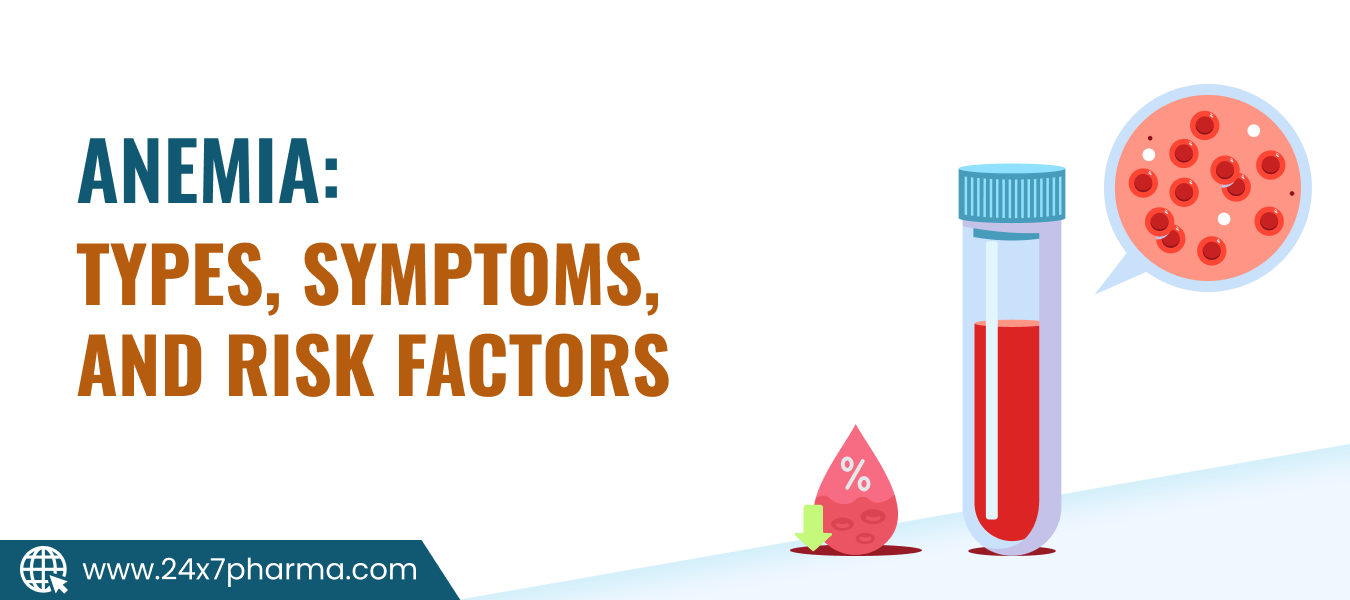Anemia is a circumstance that influences hundreds of thousands of human beings internationally, characterised by means of a lack of healthy red blood cells or hemoglobin. This deficiency reduces the oxygen-carrying capacity of the blood, leading to various health issues. Understanding , its causes, symptoms, and risk factors, can help you take proactive steps toward effective management and treatment.
How Does Anemia Work?
Anemia occurs when your body doesn’t produce enough red blood cells, loses them too quickly, or destroys them faster than they can be replaced. Red blood cells are essential because they carry oxygen from your lungs to the rest of your body through hemoglobin. Without adequate hemoglobin, your organs and tissues don’t receive the oxygen they need to function effectively, resulting in symptoms like fatigue, weakness, and shortness of breath.
Iron plays a crucial role in red blood cell production, which is why iron deficiency is the most common type of anemia. Other nutrient deficiencies, chronic diseases, and genetic conditions can also disrupt red blood cell production and lead to different types of anemia.
Types of Anemia
There are various types of anemia, each with distinct causes and characteristics. Here are the most common types:
- Iron Deficiency Anemia: The most commonplace kind of anemia as a result of insufficient iron degrees. Iron is necessary for producing hemoglobin, and its deficiency often stems from poor diet, blood loss, or malabsorption disorders.
- Vitamin Deficiency Anemia: Caused by a lack of essential vitamins such as vitamin B12 and folate, this type of anemia impairs red blood cell production.
- Aplastic Anemia: A rare but serious condition where the bone marrow fails to produce enough red blood cells due to damage or disease.
- Hemolytic Anemia: This happens while crimson blood cells are destroyed quicker than they may be changed. Causes include autoimmune diseases, infections, and inherited conditions like sickle cell anemia.
- Sickle Cell Anemia: A genetic disorder where red blood cells are abnormally shaped, leading to blockages in blood flow and reduced oxygen delivery.
- Chronic Disease Anemia: Conditions such as kidney disease, cancer, or inflammatory disorders can interfere with red blood cell production.
Side Effects of Anemia
The side effects of anemia can vary based on its type and severity. Common side effects include:
- Fatigue and weakness
- Shortness of breath
- Dizziness or lightheadedness
- Pale or yellowish skin
- Cold hands and feet
- Chest pain or irregular heartbeat
In severe cases, anemia can lead to heart complications, organ damage, or developmental issues in children. Early detection and treatment are crucial to prevent these adverse outcomes.
Symptoms of Anemia
What are the symptoms of anemia? They often develop gradually, making it easy to overlook the condition until it worsens. Common symptoms of anemia include:
- Persistent fatigue
- Shortness of breath during physical activity
- Headaches and difficulty concentrating
- Brittle nails and hair loss
- Cravings for non-nutritive substances like ice or dust (a situation known as pica)
Symptoms of anemia in women may also include heavy menstrual bleeding or complications during pregnancy, as these conditions increase the risk of iron deficiency anemia.
What Are the Risk Factors ?
Certain elements can growth the likelihood of developing anemia. Here are the most common risk factors:
- Dietary Deficiencies: A diet lacking iron, vitamin B12, or folate increases the risk of anemia.
- Chronic Conditions: Diseases like kidney failure, cancer, and autoimmune disorders can cause or exacerbate anemia.
- Genetic Disorders: Conditions like sickle cell anemia or thalassemia are inherited and predispose individuals to anemia.
- Pregnancy: Increased iron demands during pregnancy can lead to iron deficiency anemia if not managed through proper nutrition.
- Age and Gender: Children, adolescents, and women of childbearing age are at higher risk due to growth, menstruation, and pregnancy.
- Understanding the causes and risk factors of anemia is essential for effective prevention and management.
Treatments and Therapies
The treatment of anemia depends on its type and underlying cause. Common approaches include:
- Iron Therapy in Anemia: For iron deficiency anemia, oral or intravenous iron supplements are often prescribed.
- Anemia Nutrition Therapy: A balanced diet rich in iron, vitamin B12, and folate is essential.
- Vitamin and Mineral Supplements: For vitamin deficiency anemia, supplements of B12 or folate may be necessary.
- Anemia Therapy for Chronic Diseases: Treating the underlying condition can improve anemia symptoms.
- Treatment of Severe Anemia: Severe cases may require blood transfusions or bone marrow transplants.
Proper anemia therapy and medical guidance can significantly improve the quality of life for affected individuals.
The Environmental Impact
Environmental factors such as pollution and access to clean water can influence anemia rates. Exposure to toxic substances like lead can impair red blood cell production, while malnutrition due to poverty or food insecurity exacerbates anemia in vulnerable populations. Addressing these factors through policy changes and public health initiatives is crucial for reducing anemia prevalence globally.
Anemia and Physical Performance
Anemia significantly impacts physical performance, particularly in athletes and active individuals. Reduced oxygen delivery to muscles leads to fatigue, decreased endurance, and impaired recovery. For women and adolescents, addressing iron deficiency anemia through proper nutrition and iron supplementation is vital for maintaining optimal physical performance.

